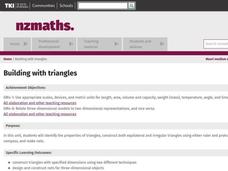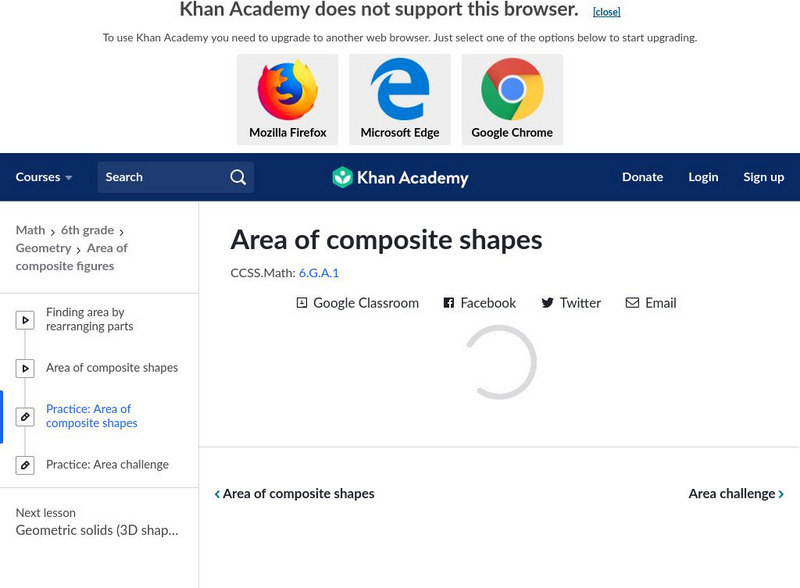Curated OER
Building With Triangles
Fourth graders use two different techniques to construct triangles with specific dimensions. They determine how to construct nets for three-dimensional objects focusing on those made with equilateral triangles. They are able to name the...
Teach Engineering
Determining Densities
Don't be dense—use a robust resource. The second installment of a five-part Floaters and Sinkers unit has learners determine the densities of several objects. As part of the activity, they learn the displacement method for finding...
Teach Engineering
Floaters and Sinkers
Whatever floats your boat. Young engineers learn about density by measuring the masses and volumes of boxes filled with different materials. Using their knowledge of densities, they hypothesize whether objects with given densities will...
Teach Engineering
Density Column Lab - Part 1
Mass and density — aren't they the same thing? This activity has groups use balance beams and water displacement to measure several objects. The pupils use the measurements to calculate the density of the objects.
Teach Engineering
Surface Tension Lab
What constitutes a good soap bubble? In the second installment of a nine-part series, scholars apply their understanding of surface tension to soap bubbles. They experiment to determine the best solutions to use for the...
Curated OER
CO2 Blow Out!
Fifth graders determine that carbon dioxide is a gas given off during respiration and that oxygent is the gas that is absorbed during respiration. They determine the air capacity of the lungs.
Curated OER
Mapping a Stream
Students map an actual local waterway. They create full color scale drawings that include windfalls, plant cover, streambed composition, and landmarks such as trees, boulders, and slumps. This is a long-term project that involves...
Shodor Education Foundation
Shodor Interactivate: Area (Elementary)
In this lesson students will practice finding the area of rectangular shapes and irregular shapes with right angles and understand why the area formula works for rectangular shapes. CCSS.Math.Content.3.MD.C.5.b A plane figure which can...
Shmoop University
Shmoop: Basic Geometry: Area of Irregular Shapes
The geometry resource investigates the area of irregular shapes. Detailed examples and practice exercises are included.
Government of Alberta
Learn Alberta: Math Interactives: Exploring Composite Figures
Investigate how a variety of shapes can be used to form composite figures using this interactive Learn Alberta math resource. Students will also work on using relevant operations and formulas to figure out the total area of composite...
Khan Academy
Khan Academy: Decompose Figures to Find Area 2
Practice decomposing irregular shapes to find their area. Students receive immediate feedback and have the opportunity to try questions repeatedly, watch a video or receive hints. CCSS.Math.Content.3.MD.C.7.d Recognize area as additive.
PBS
Pbs Learning Media: Formulas: Targeted Math Instruction
At the end of this lesson plan about formulas, students will be able to identify and apply the correct formula for a given situation, solve for any unknown component of the formulas for perimeter, circumference, and area of regular and...
National Council of Teachers of Mathematics
Nctm: Figure This: Chocolate (Pdf)
Here's a delicious math challenge for chocolate lovers! Use your estimation and measurement skills to discover which irregular shaped, chocolate covered cookie has the largest surface area. A one-page activity from the NCTM Math...
Khan Academy
Khan Academy: Area of Composite Shapes
Practice finding the areas of complex shapes that are composed of smaller shapes. Students receive immediate feedback and have the opportunity to try questions repeatedly, watch a video or receive hints.
Illustrative Mathematics
Illustrative Mathematics: G Mg How Many Leaves on a Tree? (Version 2)
For this task, students must estimate the number of leaves on a large tree, taking into account various complex factors such as the area shaded by the tree, the area of irregularly shaped leaves, the uneven distribution of leaves, the...















